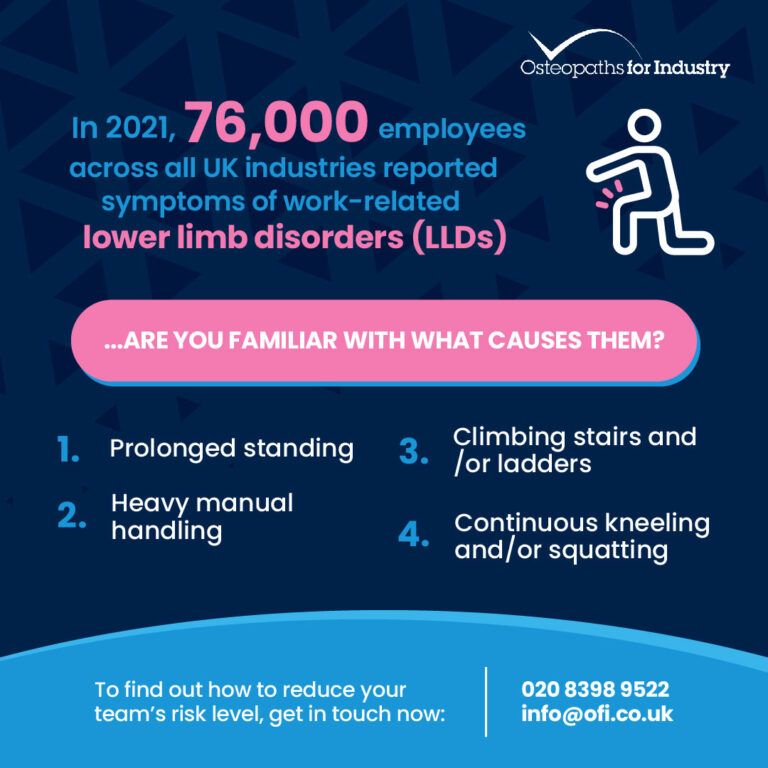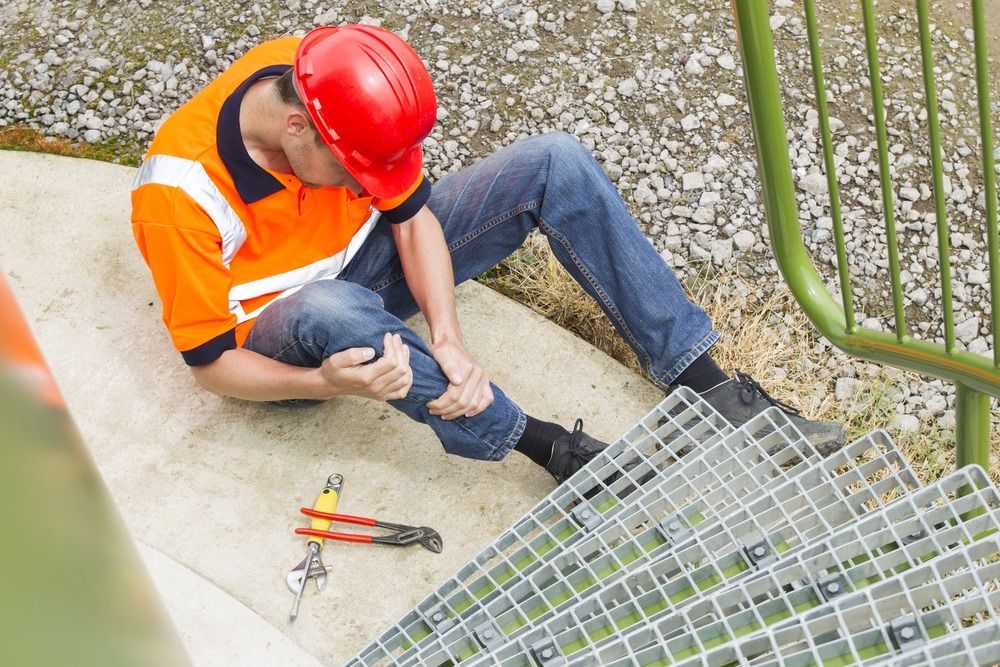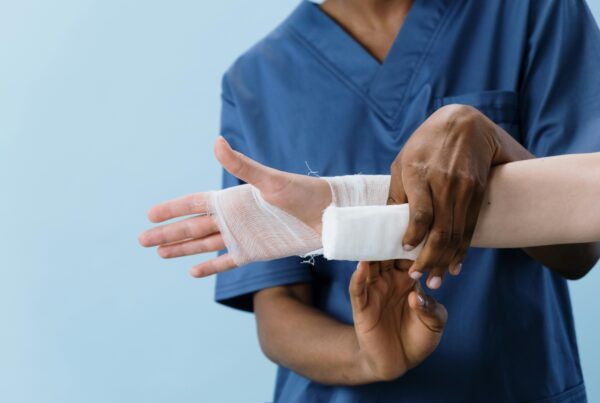Navigating Lower Limb Disorders in the Workplace
Aching knees, sore legs, swollen feet – we often associate these uncomfortable sensations with strenuous exercises, like long walks or heavy lifting in the gym. What if we told you, however, that these aches and pains could actually be being triggered by everyday tasks in your workplace?
Stiffness, pain, swelling, and injuries affecting the knees, hips, thighs, ankles, and feet all fall under Lower Limb Disorders, or LLDs. LLDs pose a serious risk to musculoskeletal health, with affectees facing long-term discomfort and even immobility. In this blog post, we’ll explore the potential occupational hazards that could risk your employees developing or worsening lower limb disorders. We’ll also review the diligence, urgency, and vigilance standards required to combat LLDs in the workplace.
What are Work-Related Lower Limb Disorders?
Lower limb disorders are a type of musculoskeletal disorder. They are categorised as separate from upper limb disorders (ULDs), which commonly affect the hands, shoulders, and neck.
Lower limb disorders instead target the following areas of the body:
- Hips
- Back
- Legs
- Knees
- Ankles
- Feet
Lower limb disorders generally cause stiffness, tenderness, cramping, swelling, and sensations of weakness in these areas of the body. Some of these symptoms are more likely to result from workplace tasks than others. The common types of work-related lower limb disorders and their symptoms include:
The common types of work-related lower limb disorders and their symptoms include:
1. Osteoarthritis: Osteoarthritis is a degenerative joint condition that causes tissues in the joints to break down over time. What this means is that the protective cartilage cushioning our bones wears down. This can lead to stiffness, joint pain, and loss of flexibility in the hips and knees.
2. Varicose veins: Varicose veins are dilated, swollen veins in the legs and feet. The enlarged veins appear purple or blue and can cause achy legs, muscle cramps, swollen feet, and scaly, itchy skin over the affected area.4
3. Knee lesions: Knee lesions can be a precursor to osteoarthritis. They occur as a result of twisting or bending the knee at the wrong angle. A lesion refers to damage to the cartilage in the joint. This damage creates friction and causes pain as the joint is unable to glide smoothly.
4. Knee bursitis: Knee bursitis refers to a swelling and inflammation of the bursa, i.e. the fluid-filled sac cushioning the joints around the knee. This inflammation limits knee movement and causes a dull, achy pain.
5. Stress fractures: Stress fractures are cracks in the bone caused by repeated micro-injuries. These hairline fractures can lead to complete bone breaks if the bones do not heal properly.
6. Deep Vein Thrombosis (DVT): Deep vein thrombosis is a blood clot in the vein, usually in the lower leg. It hardens the vein, causes swelling around the area, and may result in throbbing pain.
7. Plantar Fasciitis: Plantar fasciitis develops from damage to the plantar fascia, i.e. the ligament stretching from the heel to the front of the foot. This ligament provides a supportive cushioning to the foot, allowing us to walk and be mobile. Wear and tear of the ligament through extended pressure can inflame the plantar fascia, leading to heel pain.
Now that we are acquainted with the most common types of work-related lower limb disorders let’s move on to the occupational risk factors that may cause your employees to experience them in the workplace.
Workplace Risk Factors
The common work-related LLDs mentioned are a result of:
- Ligament wear and tear
- Pressure on the joints
- Clotting
- Sustained pressure on the lower limbs

Your employees can risk such physical damage in the following ways:
1. Continuous and repetitive kneeling and/or squatting: Repeatedly kneeling and squatting puts pressure on the knees, weakening the joints and straining the muscles around the knees and hips. It can also impede blood circulation and cause clotting and swollen veins.
2. Manual handling: Manual handling involves the lifting, movement, and dropping of a heavy load (i.e. a person, object, or animal). Bending to pick up or put down a load can compress joints in the lower limbs, while the heaviness of a load can risk minor and major injuries to the bones.
3. Prolonged standing: Tasks that require standing for an extended period can lead to muscle fatigue and stiffness around the calves, in addition to potentially damaging the plantar fascia. The blood circulation in the veins can also be impeded, risking clotting.
4. Climbing stairs and/or ladders: Climbing involves bending the knees and hips, which can potentially trigger joint stress and ligament damage. There is also a risk of falling from a height, which could cause sprains or major fractures to the bones.
Vulnerable Groups
Some of your employees may be performing tasks involving a combination of these risks, such as warehouse workers who might have to move loads, stand for continuous periods, and then climb stairs and/or a ladder to store a load. Certain types of employees are also at greater risk than others simply due to the nature of their jobs. Such individuals and/or teams are more vulnerable to developing or worsening lower limb disorders.
- Construction workers who operate heavy machinery, do manual handling work, climb ladders or scaffolding, and kneel during groundwork.
- Warehouse staff involved in the manual handling of packages, repetitively kneeling to lift/move material and climbing ladders to access or store stock.
- Farmers and agricultural workers stand for prolonged periods while checking produce, kneeling and squatting during planting and harvesting, and lifting heavy equipment.
- Retail workers who stand for prolonged periods as cashiers or while helping on the shop floor, handling merchandise, and climbing ladders/stairs.
- Maintenance staff like plumbers or electricians who have to bend and kneel to make repairs, climb ladders to access repair areas, and work with heavy tools.
Of course, LLD risks are not exclusive to these specific job categories. An office worker sitting at their desk for long periods is also vulnerable to experiencing reduced blood circulation and muscle cramping. Similarly, working in a tight, confined office can mandate kneeling, crouching, and assuming uncomfortable physical positions that can trigger musculoskeletal damage.
The growing incidence of LLDs in UK workplaces has been documented in a recent 2021 Labour Force Survey on Work-Related Musculoskeletal Disorders. The survey found that 76,000 employees across all industries reported symptoms of work-related LLDs. As an employer, such numbers should stress the urgency of boosting occupational health and safety for your employees.
Safeguarding Your Workplace: Steps to Protect Your Team’s Lower Limb Health
Your organisation’s health and wellbeing strategies must emphasise helping employees prevent LLD-related damage and recuperate their physical strength. You can confront and mitigate LLD risks in just three easy steps:
1. Conduct a thorough risk assessment: A thorough risk assessment requires identifying existing risks and examining the possibility of new ones. As an employer, you should first gather information about employees experiencing and reporting LLD symptoms through surveys and feedback reports. You can then map these symptoms against your employee’s tasks, highlighting the risk factors involved. For example, you may find that an employee experiencing joint pain in the knees is responsible for the daily storage of heavy boxes in a low cabinet. This finding provides the basis for reviewing a specific manual handling practice, i.e. the storage of the heavy box. Other helpful findings could relate to the equipment used, the number of physical tasks an employee performs on average, and whether existing preventative strategies (such as scheduling regular breaks to prevent prolonged standing) are working.
2. Implement an ergonomic work plan: An ergonomic work plan should focus on providing ergonomic equipment, offering training on safe working practices, and establishing a system for monitoring and reviewing progress. Ergonomic equipment can mean safer tools, automated lifting systems to prevent the climbing of ladders, the installation of non-slip floors and surfaces, open-floor plans for the office layout, and protective gear such as thick-soled shoes to prevent ligament damage. You should also offer training on how employees can perform their tasks without risking LLDs. For example, a training session can provide information on balancing a load by equally distributing pressure across your knees. A monitoring and review system such as feedback forms, an e-ticket service, or regularly scheduled progress meetings can help both you and your employees highlight concerns, report any LLD-related pain, recommend further changes, and facilitate such measures.
3. Get the experts in: Our highly experienced team of physiotherapists and osteopaths can help you effectively address, limit, and control the incidence of lower limb disorders in the workplace.
We can help you:
1. Conduct risk assessments, understand MSD hazards, set up ergonomic workstations, and monitor your progress against the specific requirements of your workplace through our Manual Handling Assessment and People Moving and Handling Risk Assessment services.
2. Provide manual handling training for your employees with our Manual Handling Practical Skills Training Course. This course will help you and your employees learn more about the latest manual handling regulations, provide an overview of functional anatomy, and demonstrate the best dynamic manual handling techniques needed to safeguard musculoskeletal health. The learnings from this course can be further extended in our Manual Handling Training for Instructors programme, which offers 2-4 day courses to help train your employees in expert manual handling techniques. These courses equip individuals working at your organisation to become a source of in-house health and safety support.
3. Boost awareness of ergonomic workplace practices through our Ergonomic Training Courses. These courses provide an overview of ergonomic risks in your workplace, offer practical solutions, and can train one of your employees to be an Ergonomic Champion. The Champion can help highlight issues, raise awareness of how good ergonomic practice can protect your musculoskeletal health, and disseminate resources surrounding ergonomic issues in your workplace.
This 3-step plan can help you prioritise occupational safety, provide skills training, and share expert guidance with your employees!
In Summary
In this blog post, we’ve explored the ins and outs of LLDs, learning how they not only affect physical comfort but can endanger our overall health. While the symptoms and consequences of LLDs are serious, adopting preventive and restorative measures could not be easier and more important to implement when it comes to workplace safety. From holistically assessing risks to sourcing expert guidance and training, much can be done to promote occupational safety and improve the well-being of your employees. After all, everyone wants their workplace to be healthy and happy!








